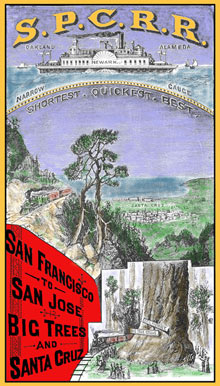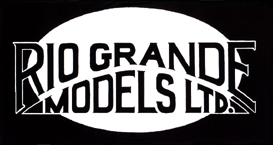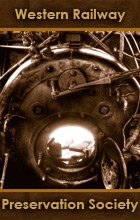

Reference Data.
Incorporated.March 20, 1876
Leased Lines.
Santa Cruz and Felton Railroad
November 13, 1874
Bay and Coast Railroad
May 2, 1877
Oakland Township Railroad
January 7, 1881
Alameda and San Joaquin Railroad
September 15, 1881 - Survey only
Felton and Pescadero Railroad
January 13, 1883
San Francisco and Colorado River R.R.
January 16, 1883
Almaden Branch Railroad
April 6, 1887
Consolidated.
South Pacific Coast Railway
May 23, 1887
Corporate Ownership.
South Pacific Coast: 1876 - June 1887
Southern Pacific: July 1887- 1937
Distances. (as of 1889)
San Francisco - via ferry
Alameda Mole - 3.0
Alameda Junction - 5.6
Pacific Avenue - 6.4
Second Street - 6.9
Webster Street - 7.2
Encinal Park - 7.6
Morton Street - 8.2
Chestnut Street - 8.7
Park Street - 9.3
Versailles Avenue - 9.7
High Street - 10.2
W. San Leandro - 14.5
W. San Lorenzo - 16.8
Russells - 19.0
Mt Eden - 20.4
Alvarado - 24.2
Halls - 25.1
Newark - 29.4
Mowrys - 31.6
Alviso - 37.9
Agnews - 40.5
Santa Clara - 43.6
San Jose - 46.2
Campbells - 50.9
Los Gatos - 55.3
Alma - 58.1
Wrights - 62.4
Highland / Laurel - 64.4
Glenwood - 65.8
Zayante - 70.0
Felton - 73.5
Big Trees - 74.3
Rincon - 76.8
Santa Cruz - 79.6
Santa Cruz Beach- - 80.6
Oakland Branch.
Alameda Mole - 3.0
Alameda Point - 5.5
First Street - 6.5
Seventh Street - 6.8
Fourteenth Street - 7.2
Boulder Creek Branch.
Felton - 73.5
Ben Lomond - 77.2
Filbert - 80.2
Boulder Creek - 80.8
Almaden Branch.
Campbells - 50.9
L.G.&S.J. Road - 52.3
Union Avenue - 53.2
Le Francs - 55.5
Guadaloupe - 56.3
Almaden Crossing - 59
New Almaden - 60.5
Tie Dimensions.
length - 69"
20" apart
Tie Material.
Redwood, from Mendocino County
and the Santa Cruz Mountains.
Rail Weight.
SC&F
35 lbs. iron rail - 1874
50 lbs. iron rail - 1880
SPC
50 lbs. iron rail - 1876
1884 60 miles of iron rail converted to 50 lbs. steel rail
South Pacific Coast Railroad.
By John Hall.A trip on the South Pacific Coast Railroad begins in San Francisco where two tracks were installed on the wharf at the foot of Market Street to store freight cars brought over from Alameda on the ferry boat Garden City. From a ferry terminal in the middle of San Francisco Bay the railroad ran along a 2.75 mile trestle to Alameda and Oakland; then down the east side of San Francisco Bay to San Jose passing the communities of Alvarado, Newark, Alviso, and Santa Clara. From San Jose the railroad began its trek over the Santa Cruz Mountains with a gentle grade up Los Gatos Creek passing Campbell's and Los Gatos before tackling the steeper grade to Wright's. At Wright's the railroad passed through a 6,157 foot tunnel to Highland and through a 5,793 foot tunnel to Glenwood. Then traversing a short tunnel came out on Zayante creek where it traveled downgrade to Felton. Crossing the San Lorenzo River at Big Trees it joined the Santa Cruz and Felton Railroad for the trip down the narrow canyon to Santa Cruz.

John Hall Collection.
Four years in construction, due to the long tunnels, the railroad opened to through service on May 15, 1880. From the first the passengers, freight, and mail provided significant profits for the railroad's investors. Powered by Baldwin locomotives with railcars from Carter, Jackson and Sharp, and others, the 98.4 mile railroad served its area well moving people and products such as lumber, lime, paper, sugar, bricks, oil, beer, gravel, and explosives. Branch lines were constructed to Centerville, Boulder Creek, New Almaden, and Berkeley with number short spurs serving various industries.
A fleet of ferryboats moved passengers from San Francisco to the trains at Alameda including a daily commuter service between Alameda/Oakland and San Francisco with two boats crossing the bay every 30 minutes; one in each direction. Local commuter trains met each boat.
In July 1887 the Southern Pacific assumed control of the South Pacific Coast and continued the narrow gauge service for 15 more years. SP began to standard gauge the railroad by adding a third rail while continuing to operate narrow gauge trains. This first started in 1893 when the Santa Cruz Union depot was constructed using dual gauge track. In 1895 the segment between San Jose and Los Gatos was converted, followed by the San Jose engine facility at Lenzen Avenue in 1899. In 1902 the streets of Alameda received dual gauge track, followed by the segment between Los Gatos and Wrights in 1904. Between 1904 and 1906 the remainder of the line was converted only to be interrupted by the 1906 San Francisco earthquake. The collapse of the tunnels in the Santa Cruz Mountains delayed the opening of the standard gauge line until May 29, 1909 when the first through standard gauge train reached Santa Cruz from Oakland.
Portions of the original alignment are still in use today. The Union Pacific operates the sections of track from San Leandro to San Jose and San Jose to Vasona Junction near Campbell. The Santa Cruz, Big Trees & Pacific Railway operates along the 1875 segment o f the line from Felton to Santa Cruz.
Reference Material Available Online:
Photographs.
Collected South Pacific Coast Railroad Photographs.
Images collected from private collections, libraries and historical societies.
Maps.
The South Pacific Coast Railroad ca. 1886 for Google Earth
By John Hall
Trackage
South Pacific Coast Track Status Timeline. by John Hall.  32.1 KB
32.1 KB
A timeline of track life, including: construction, service dates and guage changes.
Newspaper Clippings.
Coming Soon!
Color Cards.
Color swatches using PMS color representing the paint layers found on the carbody.
Color Card: South Pacific Coast - Coach #39: Body  1.48 MB
1.48 MB
Color Card: South Pacific Coast - Caboose #47: Body  0.88 MB
0.88 MB
Paint References.
Color Card: South Pacific Coast - Coach #42 circa 1904. by Andrew Brandon  0.97 MB
0.97 MB
Drawn to Southern Pacific Common Standards, using paint samples taken from Coach #39 by Randy Hees, Dimensional Data from Mike Collins and Bruce MacGregor.
Organizations.
Society for the Preservation of Carter Railroad Resources.
Dedicated to the preservation of equipment built by the Carter Brothers and other car builders of the west coast.



